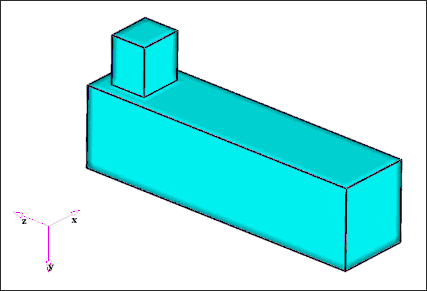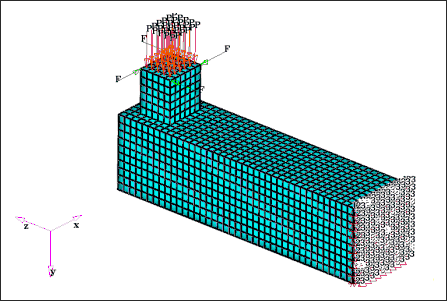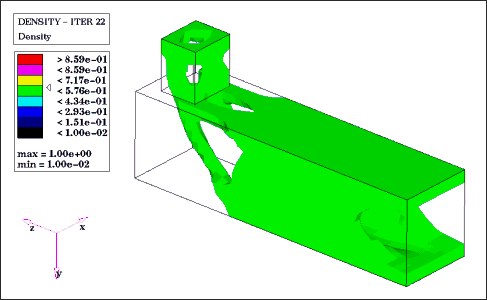Introductory Example of Topology Optimization |

|

|

|

|
|
Introductory Example of Topology Optimization |

|

|

|

|
To develop a new design for a socket wrench, you are given:
| • | The design space |
| • | The maximum forces that may develop during use |
| • | A mass target |
A finite element model representing the design space is created and the loads and boundary conditions are applied.

Design Space.

FE model of design space with loads and constraints applied.
The end of the handle is assumed to be fixed. Forces simulating service conditions are applied at the tip. The mass of the optimized design and other parameters are specified before topology optimization. OptiStruct initializes the design space by distributing the available material evenly to all elements.
OptiStruct uses an iterative process to determine the optimum distribution of material using the Solid Isotropic Material with Penalization (SIMP) method. In the density method, the rho-mat is used directly as the density design variable. The material density varies continuously between 0 and 1. These represent the void and solid states respectively for each element. The stiffness of the material is assumed to be linearly dependent on its density.
Areas of intermediate density are fictitious when looked at from a practical standpoint. This is due to the fact that the presence or absence of material at a particular region is deduced from the density being either 1 or 0, respectively. All other values of density are practically meaningless. Therefore, the intermediate densities are penalized to force the final design to be represented by densities of only 0 or 1 for each element. Ideally, on convergence, the finite element model is transformed into a structure with elements having either a density near 1.0 (representing material) or 0.0 (representing no material). The load paths in the structure are prominently displayed at the end of the optimization.

Structure of the socket wrench after 22 iterations.
A design for the socket wrench is generated using the OptiStruct solution. The solution shows major load paths running from the tip, which is loaded with a torque and surface pressure, to the rigidly held areas farthest on the handle. Translators provided with OptiStruct can be used to generate IGES surfaces which can be imported into any CAD system for developing a complete design concept. A finite element model of the concept can also be developed for analysis and, if necessary, further optimization using size and shape optimization methods can be performed.
See Also: